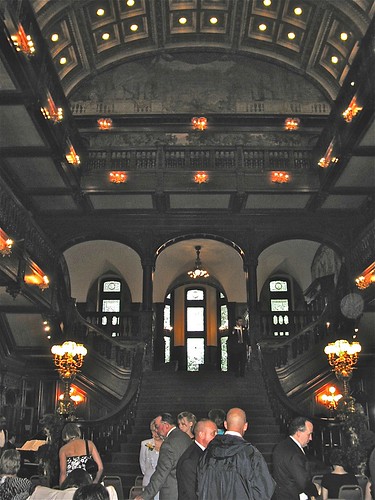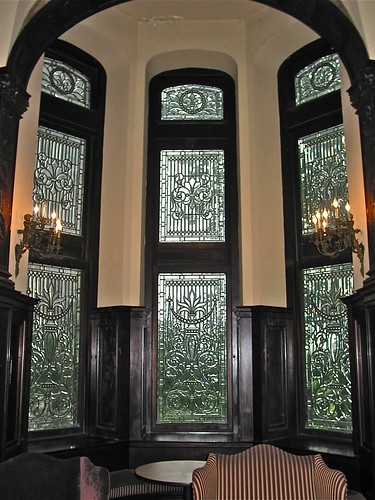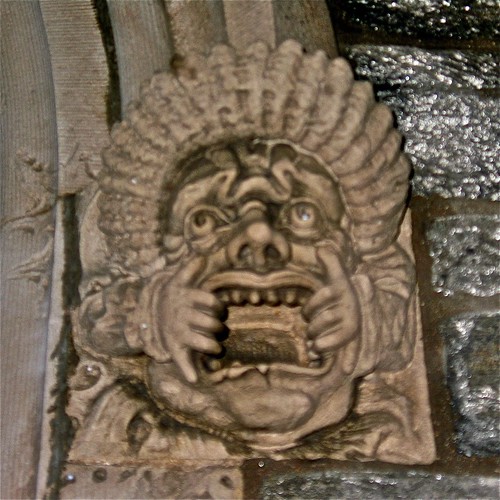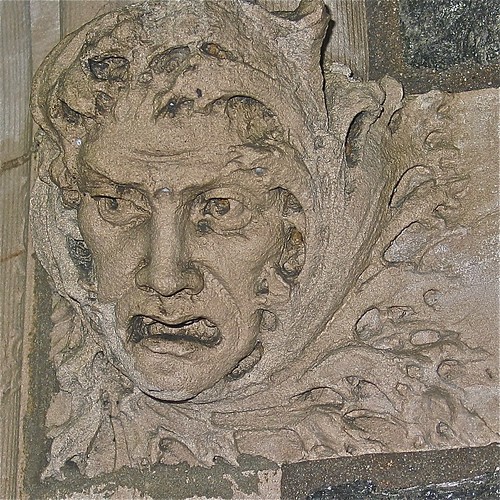Grey Towers Castle (1893) – expansive interior
Image by origamidon
Glenside, Pennsylvania USA • Constructed in 1893, this American "castle" typifies the architectural complexes built for families of great wealth at the turn of the century, symbolizing their social aspirations. This was the first major commission of Horace Trumbauer (1869 -1938), a successful architect of European-revival styles; today it is Arcadia University (formerly known as Beaver College.) – From the NPS Statement of Significance.
Grey Towers Castle was built in the late 1890’s by architect Horace Trumbauer, whose firm helped build the Philadelphia Museum of Art, for sugar millionaire William Welsh Harrison. The castle was designed to resemble Alnwick Castle in England and was built to replace Harrison’s Rosedale Hall home which burned to the ground on the same site in 1893. The estate was purchased by Arcadia College in 1929 and today serves as a dormitory as well as home to the office of the president and the Offices of Admissions, Enrollment Management, and Financial Aid. Harrison was reportedly a philanderer and had secret passageways built into the castle to conduct his affairs with his mistresses including many female servants and maids. – From 19 Beautiful Famous Castles in Pennsylvania, by Joe Dorish.
☞ On February 14, 1980, the National Park Service added this structure, also known as the William Welsh Harrison House, to the National Register of Historic Places (#80003578).
☞ On February 4, 1985, the National Park Service designated this structure a National Historic Landmark (also, #80003578).
National Historic Landmarks are nationally significant historic places designated by the Secretary of the Interior because they possess exceptional value or quality in illustrating or interpreting the heritage of the United States. Today, fewer than 2,500 historic places bear this national distinction. [And only 17 in Vermont.] Working with citizens throughout the nation, the National Historic Landmarks Program draws upon the expertise of National Park Service staff who work to nominate new landmarks and provide assistance to existing landmarks.
National Historic Landmarks are exceptional places. They form a common bond between all Americans. While there are many historic places across the nation, only a small number have meaning to all Americans--these we call our National Historic Landmarks. – From the National Park Service.
☞ More photos of this and other National Historical Landmarks.
• More Info: GeoHack: 40°4′53″N 75°9′54″W.
Grey Towers Castle (1893) – stained-glass tower windows
Image by origamidon
Glenside, Pennsylvania USA • Constructed in 1893, this American "castle" typifies the architectural complexes built for families of great wealth at the turn of the century, symbolizing their social aspirations. This was the first major commission of Horace Trumbauer (1869 -1938), a successful architect of European-revival styles; today it is Arcadia University (formerly known as Beaver College.) – From the NPS Statement of Significance.
Grey Towers Castle was built in the late 1890’s by architect Horace Trumbauer, whose firm helped build the Philadelphia Museum of Art, for sugar millionaire William Welsh Harrison. The castle was designed to resemble Alnwick Castle in England and was built to replace Harrison’s Rosedale Hall home which burned to the ground on the same site in 1893. The estate was purchased by Arcadia College in 1929 and today serves as a dormitory as well as home to the office of the president and the Offices of Admissions, Enrollment Management, and Financial Aid. Harrison was reportedly a philanderer and had secret passageways built into the castle to conduct his affairs with his mistresses including many female servants and maids. – From 19 Beautiful Famous Castles in Pennsylvania, by Joe Dorish.
☞ On February 14, 1980, the National Park Service added this structure, also known as the William Welsh Harrison House, to the National Register of Historic Places (#80003578).
☞ On February 4, 1985, the National Park Service designated this structure a National Historic Landmark (also, #80003578).
National Historic Landmarks are nationally significant historic places designated by the Secretary of the Interior because they possess exceptional value or quality in illustrating or interpreting the heritage of the United States. Today, fewer than 2,500 historic places bear this national distinction. [And only 17 in Vermont.] Working with citizens throughout the nation, the National Historic Landmarks Program draws upon the expertise of National Park Service staff who work to nominate new landmarks and provide assistance to existing landmarks.
National Historic Landmarks are exceptional places. They form a common bond between all Americans. While there are many historic places across the nation, only a small number have meaning to all Americans--these we call our National Historic Landmarks. – From the National Park Service.
☞ More photos of this and other National Historical Landmarks.
• More Info: GeoHack: 40°4′53″N 75°9′54″W.
Grey Towers Castle (1893) – carved stone gargoyle
Image by origamidon
Glenside, Pennsylvania USA • Constructed in 1893, this American "castle" typifies the architectural complexes built for families of great wealth at the turn of the century, symbolizing their social aspirations. This was the first major commission of Horace Trumbauer (1869 -1938), a successful architect of European-revival styles; today it is Arcadia University (formerly known as Beaver College.) – From the NPS Statement of Significance.
Grey Towers Castle was built in the late 1890’s by architect Horace Trumbauer, whose firm helped build the Philadelphia Museum of Art, for sugar millionaire William Welsh Harrison. The castle was designed to resemble Alnwick Castle in England and was built to replace Harrison’s Rosedale Hall home which burned to the ground on the same site in 1893. The estate was purchased by Arcadia College in 1929 and today serves as a dormitory as well as home to the office of the president and the Offices of Admissions, Enrollment Management, and Financial Aid. Harrison was reportedly a philanderer and had secret passageways built into the castle to conduct his affairs with his mistresses including many female servants and maids. – From 19 Beautiful Famous Castles in Pennsylvania, by Joe Dorish.
☞ On February 14, 1980, the National Park Service added this structure, also known as the William Welsh Harrison House, to the National Register of Historic Places (#80003578).
☞ On February 4, 1985, the National Park Service designated this structure a National Historic Landmark (also, #80003578).
National Historic Landmarks are nationally significant historic places designated by the Secretary of the Interior because they possess exceptional value or quality in illustrating or interpreting the heritage of the United States. Today, fewer than 2,500 historic places bear this national distinction. [And only 17 in Vermont.] Working with citizens throughout the nation, the National Historic Landmarks Program draws upon the expertise of National Park Service staff who work to nominate new landmarks and provide assistance to existing landmarks.
National Historic Landmarks are exceptional places. They form a common bond between all Americans. While there are many historic places across the nation, only a small number have meaning to all Americans--these we call our National Historic Landmarks. – From the National Park Service.
☞ More photos of this and other National Historical Landmarks.
• More Info: GeoHack: 40°4′53″N 75°9′54″W.
Grey Towers Castle (1893) – carved stone gargoyle
Image by origamidon
Glenside, Pennsylvania USA • Constructed in 1893, this American "castle" typifies the architectural complexes built for families of great wealth at the turn of the century, symbolizing their social aspirations. This was the first major commission of Horace Trumbauer (1869 -1938), a successful architect of European-revival styles; today it is Arcadia University (formerly known as Beaver College.) – From the NPS Statement of Significance.
Grey Towers Castle was built in the late 1890’s by architect Horace Trumbauer, whose firm helped build the Philadelphia Museum of Art, for sugar millionaire William Welsh Harrison. The castle was designed to resemble Alnwick Castle in England and was built to replace Harrison’s Rosedale Hall home which burned to the ground on the same site in 1893. The estate was purchased by Arcadia College in 1929 and today serves as a dormitory as well as home to the office of the president and the Offices of Admissions, Enrollment Management, and Financial Aid. Harrison was reportedly a philanderer and had secret passageways built into the castle to conduct his affairs with his mistresses including many female servants and maids. – From 19 Beautiful Famous Castles in Pennsylvania, by Joe Dorish.
☞ On February 14, 1980, the National Park Service added this structure, also known as the William Welsh Harrison House, to the National Register of Historic Places (#80003578).
☞ On February 4, 1985, the National Park Service designated this structure a National Historic Landmark (also, #80003578).
National Historic Landmarks are nationally significant historic places designated by the Secretary of the Interior because they possess exceptional value or quality in illustrating or interpreting the heritage of the United States. Today, fewer than 2,500 historic places bear this national distinction. [And only 17 in Vermont.] Working with citizens throughout the nation, the National Historic Landmarks Program draws upon the expertise of National Park Service staff who work to nominate new landmarks and provide assistance to existing landmarks.
National Historic Landmarks are exceptional places. They form a common bond between all Americans. While there are many historic places across the nation, only a small number have meaning to all Americans--these we call our National Historic Landmarks. – From the National Park Service.
☞ More photos of this and other National Historical Landmarks.
• More Info: GeoHack: 40°4′53″N 75°9′54″W.
Pittsburgh - Oakland: University of Pittsburgh - Clapp Hall
Image by wallyg
George Hubbard Clapp Hall is a six-story Gothic Revival structure designed by Trautwein & Howard in 1956. The primary facility of the University of Pittsburgh Department of Biological Sciences, it contains laboratories, classrooms, a greenhouse, and an amphitheater-style lecture hall with 404 seats.
Clapp Hall's exterior and interior spaces have been described as a mix of Collegiate Gothic and Art Deco. The building features a diagonally-positioned entrance that creates a direct axis with the Cathedral of Learning which is framed in Clapp Hall's stone portal entryway. The building is clad in textured Indiana limestone to match the stone used on the Cathedral of Learning.
The University of Pittsburgh, a state-related research university, commonly referred to as Pitt, was originally founded as Pittsburgh Academy in 1787 on what was then the American frontier. Pitt evolved into the Western University of Pennsylvania with an alteration to its charter in 1819, and upon relocating to its current campus in the Oakland neighborhood of Pittsburgh in 1908, the school received its current moniker, the University of Pittsburgh. For most of its history Pitt was a private institution, until it became part of the Commonwealth System of Higher Education in 1966.
The Schenley Farms Historic District, part of the Schenley Farms-Oakland Civic District, is noted for its late 19th And 20th Century Revivals architecture, and home to a large portion of the campus of the University of Pittsburgh.
Schenley Farms Historic District #830002213 (1983)
No comments:
Post a Comment